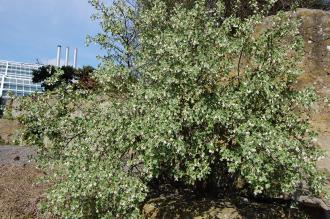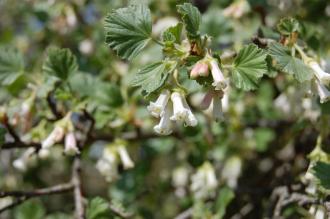
Ribes cereum var cereum (21/04/2013, Kew Gardens, London)
Position: Full sun to light shade
Flowering period: Spring to early summer
Soil: Moist, well drained
Eventual Height: 2m
Eventual Spread: 2m
Hardiness: 3a, 3b, 4a, 4b, 5a, 5b, 6a, 6b, 7a, 7b, 8a, 8b, 9a, 9b, 10a, 10b
Family: Grossulariaceae
Ribes cereum var cereum is a deciduous shrub with a spreading to erect habit. Its dark green leaves are rounded with shallow lobes and serrate margins, have a waxy secretion on their surface, up to 2.5cm long and 3cm broad. Its white/ pink flowers are tubular, up to 8mm long and appear in racemes of up to 9. Its red fruit is a berry and up to 1cm across.
Ribes cereum var cereum, commonly known as the Wax Currant or Squaw Currant, is native to west North America. In its native habitat it grows at the edges mountain forests and woodlands. This shrub is a host for white pine blister rust (Cronartium ribicola) which infests five-needled pines.
The etymological root of the binomial name Ribes, is likely be from the Arabic Ribas, which refers to a plant now known as Rheum ribes which was used by Arabian physicians for its acidic properties. Cereum is from the Latin meaning ‘waxy’, in reference to the secretion exuded by its leaves.
The landscape architect may find Ribes cereum var cereum useful as an attractive shrub which provides nectar, food and cover for wildlife.
Ecologically, Ribes cereum var cereum flowers are attractive to pollinating insects. Its fruit are attractive to birds and some mammals.

Ribes cereum var cereum Flower (21/04/2013, Kew Gardens, London)
Ribes cereum var cereum prefers moist, fertile, well-drained soils. It tolerates most pH of soil.
Ribes cereum var cereum requires little maintenance.

